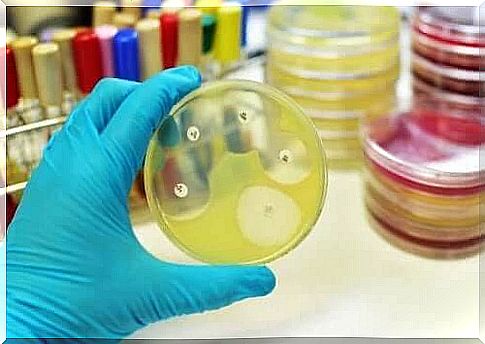Rifampicin And Tuberculosis: Everything You Need To Know

Rifampicin is an antibiotic that is part of the rifampicin family. It is a semi-synthetic compound and it is the first choice for the treatment of tuberculosis. In this article, we tell you everything you need to know about the relationship between rifampicin and tuberculosis.
However, this medicine should not be used as monotherapy. In other words: Rifampicin should not be used as the only medicine that the patient receives to treat tuberculosis. This would favor the development of antibiotic-resistant bacteria. Therefore, doctors prescribe this medicine along with other forms of medicine.
Rifampicin can also treat patients who carry the Neisseria meningitides bacterium but who do not show symptoms. Furthermore, rifampicin is effective for the prophylactic treatment of Haemophilus influenzae type B and for the treatment of leprosy.
The story of rifampicin

This antibiotic first appeared on the market in the 1960s. Researchers first obtained rifampin B, which is a metabolic product of rifampin.
They then tried to make a series of structural changes to the molecule to increase its antibiotic potency while reducing rapid bile elimination. Eventually, they were able to synthesize rifampicin.
Since rifampicin came on the market, it has been considered as the first treatment method of tuberculosis. However, the bacterium became resistant to rifampin, and this forced doctors to administer other drugs with it, such as isoniazid and ethambutol.
But the discovery of rifampin was undoubtedly a breakthrough in the world of medicine.
What is tuberculosis?
Tuberculosis is a disease that results from a bacterial infection. More specifically, it is from the bacterium Mycobacterium tuberculosis . In most cases, this microorganism affects the lungs.
Infected people can spread the disease through the air when they sneeze or cough. Unfortunately, it is enough to inhale the particles to become infected.
However, tuberculosis is a preventable disease and today doctors can cure most patients. Since 2000, more than 49 million have been cured thanks to modern diagnosis and treatment.
As for the signs and symptoms of this disease, it depends on the area where the bacterium multiplies. As we mentioned earlier, it is usually the lungs that are affected and it causes the following symptoms:
- Intense and persistent cough
- Chest pain
- Cough followed by bloody vomiting
- Fever and chills
- Weight loss
- Lost appetite
How does rifampicin work?

Rifampicin owes its antibiotic effect to its ability to inhibit the RNA synthesis of bacterial cells. To do this, it inhibits the action of RNA polymerase, a DNA-dependent enzyme. Rifampicin does not bind to the polymerase of eukaryotic cells, such as those of humans, so it does not affect the synthesis of human RNA.
This medicine is a bacteriostatic or bactericidal medicine, depending on the dose given. A smaller dose will be bacteriostatic. That is, it prevents the development of bacterial cells. At a higher dose, it will have a bactericidal effect. In other words, it kills the bacteria.
What is the appropriate dose?
The dosage will vary from patient to patient. The recommended dose for an adult patient who is not infected with HIV is given both orally and intravenously at a maximum dose of 600 mg per day. If the patient has HIV, the dose will be 10 mg / kg both orally and intravenously.
In the case of children who are HIV-negative, the dose is reduced to 10-20 mg / kg per day, with a maximum dose of 600 mg. But it is always combined with other antituberculous drugs. If the child is infected with HIV, the dosage will be the same.
Patients take the medicine once a day for two months with another antituberculous medicine. Next, the patient should take isoniazid and rifampin at the same dose once a day or 2-3 times a week for the next four months.
Conclusion
Rifampicin is an antibiotic used to treat tuberculosis in combination with other types of medicine. The combination became necessary due to the resistance that the bacterium developed to the medicine itself.
If you have any further questions on the use of this product, ask your doctor or pharmacist. You should always follow the instructions given to you by your doctor. Abuse of the medicine can cause serious health problems.









